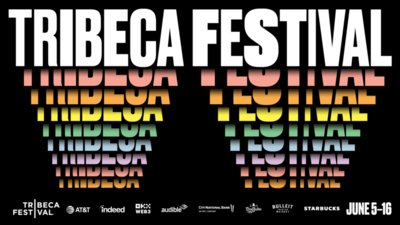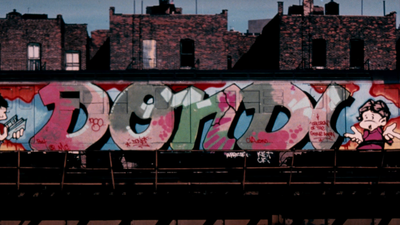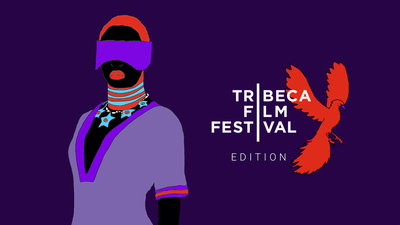
BY MARIAH PHILLIPS |
Behind the Scenes of a Music Video Collaboration: Big Data + Ghost Cow Films
We sat down with Big Data and Ghost + Cow films to talk about their recent collaboration on the funny and dark 'Dangerous' video.
Last year, we talked to Big Data's Alan Wilkis and interactive video maker Rajeev Basu about their interactive video Facehawk. Now, Wilkis has teamed up with John Carlucci and Brandon LaGanke of Ghost+Cow Films for a provocative and funny music video that skewers the advertising industry for Big Data's song 'Dangerous,' above. (The song is a hit - currently #1 on SiriusXM's Alt Nation.) We talked to the musician and filmmakers about their collaboration and how media impacts storytelling.
Tribeca: How quickly do you know whether or not a collaboration will work, and was there ever a time you were wrong?
BRANDON & JOHN, Ghost+Cow Films: I think you know right away. You’ve seen or heard their work prior to the meeting, and you wouldn’t take the meeting unless you loved what they were doing. So, right off the bat, Alan had that going for him. We loved his music, and Alan immediately struck us as a great dude.
[Modern Artists] know that you can’t just be good at making music anymore; you need the full package.
But the biggest thing for us, and having worked with many bands in the past, he was so extremely organized and determined. He had a plan. Alan isn’t just a musician. He’s a media artist. He looks at the big picture and knows how to market himself and his brand. Those are modern artists. The ones that know that you can’t just be good at making music anymore; you need the full package. That was very refreshing for us.
ALAN WILKIS, BIG DATA: I can tell pretty quickly, typically. If I don't get a gut feeling right out of the gate, I'm unlikely to pursue a collaboration. B&J have a very clear and odd (in the good sense) perspective on the world, and it shines through in their work. I think we all knew within minutes of that first conversation that we were on the same page and all wanted to make weird, provocative, and inspiring art together.
With any great collaboration, you need to feel comfortable and respect each other enough to stand your ground on the things you believe in, while remaining open-minded to your collaborators’ beliefs. There were times when the three of us butted heads (no pun intended) on certain creative things, but those instances forced us to think through and make decisions together. We were able to push each other and the end-product to such a higher place and hold everything to such a high standard. It was the give-and-take of our collaboration that yielded the best and most unexpected results, and it really brought us all closer together.
It leaves me feeling like, "This is EXACTLY how someone would market a pair of evil shoes that makes you headbutt people."
Tribeca: How did you decide to make this video? What about this song/video do you think resonates with the audience?
ALAN: We wanted to turn advertising on its head a bit by taking something familiar and twisting it - the commonplace tropes of using sex and violence to sell a product, even if that product isn't good for the consumer... and in this case, REALLY bad for the consumer. What resonates most for me, at least, is that it shows a very real approach to a very surreal story. It leaves me feeling like, "This is EXACTLY how someone would market a pair of evil shoes that makes you headbutt people."
BRANDON & JOHN: The concept is, simply, to illustrate how an evil corporation like a running shoe that makes you head butt people would market their product. The world is a fucked up place. That would be our movie poster tagline if this was a feature: “The world is a fucked up place.” We see the danger because of our connection to the ad world. We met at an agency, and were exposed to many things that we are parodying in ‘Dangerous’, in the whole product-to-campaign process and the brand and client relationships that are just insane. It’s something that is tragically hilarious and thats kind of what we were going for. So we were able to draw from a familiar well. I hope the satire resonates with the audience. I hope they see something hilarious and ridiculous that is rooted in a sense of truth. There’s a lot of things to think about, and maybe laugh about or cry about. Commercialism obviously, sexism, feminism, capitalism. Its all about the isms.
Tribeca: Why did you decide to make another video for “Dangerous” after the success of the first one? This video is completely different aesthetically--did you actively seek out filmmakers with diverse creative mediums?
ALAN: I like to think of "Facehawk" as more of an interactive experience, as opposed to a proper video. I think wanted to make a traditional video, in addition to the interactive piece, because I simply love film and making videos. I was actually already familiar with some of Brandon and John's work in the past - particularly their amazing and insane video for the band CHAPPO. B&J are immensely creative and have a very unique perspective consistent through their work. They're able to incorporate elements of darkness and humor in such a special way.
Also, doing music videos really allows filmmakers to hone in on their craft and showcases what they can bring to a longer form or commercial project.
Tribeca: What was your reaction when you first heard the idea for the video?
ALAN: I actually was the one to bring the basic evil-commercial concept to John and Brandon. There was an afternoon in early 2013 when Dan (of the band Joywave / the singer & co-writer of "Dangerous") and I were in the studio together, and we started talking about an idea of making a music video that was a commercial for a running sneaker, except that something was clearly off about the commercial. And gradually over time, it would be revealed that the shoe made you do something awful and evil.
The first time we all met up, I presented them with the rough "commercial" idea, and then the three of us spent about two months working on the script and fleshing out the concept. They were the ones to step back from the "commercial" world itself and introduce the ideas of the scientists and the ad agency, brand, and mechanisms behind the actual marketing of the shoe. There was one boozy lunch in particular where we had the "a-HA" moment for the exploding headbutt idea. The storyline was a true collaboration between the three of us, as was the production and execution of the video. From start to finish, the video took about 11 months of consistent work, and we were in constant communication every step of the way.
Tribeca: How does your mindset change when fleshing out ideas for a music video as opposed to a traditional film? And for a music video versus a commercial? What technical changes did you consciously make, especially with such an ambitious project?
BRANDON: It’s much different because there’s no dialogue of course, but the big difference is the flexibility. I mean, you can go anywhere you want with a music video. It could be purely visual, it could have a strong narrative or it could be experiential like what Chris Milk has been doing these past recent years. That’s why we love this medium. There’s really no rules. And, as long as it’s not for air and the label/artist is on board, you can go really far with it, as we hope you saw in this video.
JOHN: Agreed, there are no rules. There’s always a joke on the set of a music video that if someone on the team doesn’t understand what’s being shot or they think a sequence isn’t going to make sense in the end result you say “it's a music video, it doesn’t have to make sense.” Music videos allow an endless playing field of creativity which is what we want.
As filmmakers, I don’t think we should limit ourselves to any one kind of assignment.
Tribeca: What was the biggest challenge faced during the filming process? And in post-production? Did you work with any new equipment (camera, effect, etc.)?
BRANDON AND JOHN: You can do whatever you want in a music video, but the flip side to that is money. There’s simply no money in music videos anymore. No one is willing to pay for them. Unless you’re doing a Katy Perry video. So, that’s a major challenge. Getting a crew to work for free or peanuts, getting free gear, a free stage, free locations, cheap, but good actors, etc, etc. That is a challenge we had to deal with every day. But here’s how you can get around all of that: Make sure it’s a fucking amazing concept. If it’s amazing, people will want to be a part of it. Because we’re all making baby diaper commercials and shooting corporate events for money. Who doesn’t want blood, dicks, boobs and headbutting shoes on their reel? The same goes for making a film. You need great ideas to get great people. That will make a great film. As far as equipment, we didn’t really work with anything new, but we were able to work with great gear and great companies. We shot on the Red Epic, which came with a great DP, Paul McCarthy. And then in post, we were lucky to work with great companies like The Mill and great Visual Effects people like Dan Bowhers, so that was pretty awesome.
Tribeca: What advice would you give filmmakers looking to branch out into alternative forms of storytelling (i.e., music videos)?
BRANDON AND JOHN: Don’t worry about the budget and don’t be afraid to try other genres. Anyone can make a film nowadays. iPhones are now better looking than DV cameras were in 2003. Focus on an amazing concept and work back from that. Above all, just make stuff. I know a lot of filmmakers who claim they would never make a music video. I’m confused by that. Why not take the opportunity to make something that gets you out and shooting. I feel like you learn something from every shoot, and you learn great cheap tricks on music videos which are great for a filmmaker’s wheelhouse.
As filmmakers, I don’t think we should limit ourselves to any one kind of assignment. We all want to be feature filmmakers. That’s no big secret. Music videos, commercials, industrials, live projections, whatever, are all learning opportunities. Whenever we meet with Reps or EPs, their first question is, what kind of filmmaker are you because they need to know how to market you. It sucks, and personally we hate answering this question. Why do we have to be docu-style directors or comedy directors? We love it all. Fuck it. Do it all. Learn from it. Never say no. Take the Pampers commercial. And then poach the amazing gaffer you worked with on that commercial for your feature...

